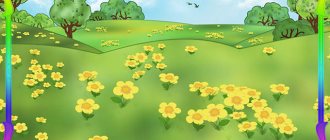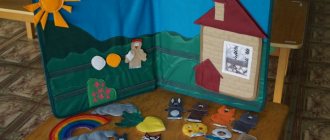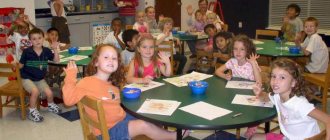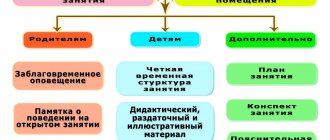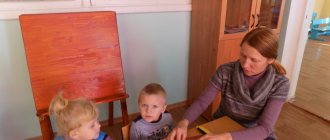Summary of direct educational activities on the topic: “Hen and Chicks”
Aidabekova Anna Gusenovna teacher of the first qualification category of the GBDOU kindergarten No. 44 of the compensatory type St. Petersburg, Kolpino
Participants: children with mild mental retardation aged 3-7 years.
Number of children: subgroup 4 people.
Duration: 15 minutes
Goal : introduce children to chickens and chickens.
Tasks:
1. Clarify children’s ideas about poultry - hens and chicks.
2. Learn to answer questions using means of communication accessible to children: words, gestures.
3. Learn to reproduce specific actions shown by the teacher, develop auditory attention, and activate the vocabulary.
Pedagogical intent:
Educational area Socialization
Tasks:
- create interest in children in gaming activities together with the teacher.
— consolidate children’s knowledge about the body structure of chickens.
- consolidate the ability to distinguish a chicken from other birds.
Educational field Communication
Tasks:
— to cultivate a communicative culture in children: the ability to answer the teacher’s questions, perform creative work in a subgroup.
Educational field Artistic creativity
Tasks:
— To develop the ability to glue lumps of yellow paper onto a chicken stencil according to a sample;
- take the lumps one at a time, spread the glue with smooth movements;
- learn to work carefully;
Preliminary work
Material:
Character - chicken, yellow lumps of paper, oilcloth, napkins, glue, brushes, demonstration pictures depicting chicks: ducks, goose, chicken.
With children, carried out :
We looked at poultry and chicks, played didactic games with them, read about them, created homemade books about poultry, drew and sculpted.
Progress of joint activities:
- Organizational stage: outdoor game.
- Main stage: conversation, didactic game.
- Preparation for application
- Finger gymnastics
- Pasting lumps
- Reflection stage
The character's entrance is a pockmarked hen. (teacher). Say hello to the children: show the children how big and beautiful the chicken is, with wings and beak, what kind of comb and eyes it is, repeat with the children: head, comb, eyes, beak, neck, wings, tell the children that I live in a poultry yard with other poultry.
Invite children to turn into pet birds. ( active game “Our ducks in the morning...” )
Ask the children how I call my chickens? That’s right, “Ko-ko-ko,” says the chicken. But there are no chickens in sight. Where are the chickens?
Invite children to choose from the proposed pictures an image of a chicken and describe it. Yellow, fluffy, small. What kind of chickens? How do chickens talk? That's right, "pee-pee-pee" - say the chickens.
Didactic game “Show and name.”
Please show me the chicken's beak. Where are the eyes, wings, tail? (Individual work). Children point with their fingers and name body parts.
Tell the children that the chicken is bored without chickens, help me glue together chickens from lumps of paper.
Sit at the tables, keeping your back straight, legs under the table.
To keep your fingers from getting tired, invite the children to play a finger game .
The crested hen walked around the yard, led the children (walking with their fingers on the table), fanned the comb (fist-palm), amused the little children (flashlights)
Show the sequence of work, place the sample at the children’s eye level.
Offer to start doing the work.
Result: children with their chickens come up to the chicken and give it to her.
The hen (teacher) really likes chickens. I want to play with you like chickens.
Physical school
The chicken went out for a walk, to nibble some fresh grass (the children follow the teacher in a circle)
And behind her are the boys, yellow chickens.
“Ko-ko-ko, ko-ko-ko, don’t go far, (we shake our fingers)
Row with your paws, look for grains. (sit down and row with your hands)
The teacher is a chicken, the children are chickens. Children repeat the movements after the teacher.
The children are great, they did the task well, the hen is happy and says that it’s time for the hen and chickens to go home to the chicken coop, but in the evening we will be back to show moms and dads what beautiful chickens you made. Goodbye children. The chicken leaves.
Planned result:
— Reinforce in your memory that chickens are chicken chicks.
— To consolidate knowledge of the body parts of chickens.
— Involve children in performing applique according to the model, in the correct sequence.
Further work:
— Continue to introduce children to other types of artistic creativity.
— Continue to introduce children to poultry and their chicks.
Author: Aidabekova Anna Gusenovna Position: teacher of the first qualification category Place of work: GBDOU kindergarten No. 44 of compensatory type Location: St. Petersburg, Kolpino
Date modified: 03.12.2014
Lesson summary “Ryaba Hen” 1st junior group
Developmental lesson for children 2-3 years old on the topic “Ryaba Hen”
Program content. 1. Develop children’s creative imagination, teach them to imitate the facial expressions and movements of fairy tale characters. Develop facial and intonation expressiveness. 2. Learn to look at plot pictures, answer questions about the picture, clarify the concepts of “many” and “one”. 3. Develop visual attention, teach visual control and coordination of your actions. 4. Develop auditory attention, learn to perform movements in accordance with the nature of the music. 5. Learn to draw round objects using a shaping motion, wash the brush before applying other paint. Arouse positive emotions from the result of the activity. Material. Flannelgraph and theater for the flannelgraph “Ryaba Hen” (or toy theater, or another type of theater), attributes for dramatization: elements of mumming, a golden egg, a wooden spoon, pictures for a fairy tale with pronounced emotions, a didactic game “What shell is this chicken from? ", pictures "Find the differences", musical accompaniment for physical exercises, for drawing: blank (drawn basket), brushes, paints.
Progress of the lesson
I. Telling the fairy tale “Ryaba Hen” with a display on a flannelgraph. II. An exercise to develop facial expression. Teacher (asks children questions based on the pictures, helps with answers). Why are grandparents surprised in this picture? Be surprised, like grandparents. What are they doing in this picture? Why are they crying? Show how grandparents cry. Who are the grandparents in this picture? Grandfather and grandmother are cheerful. The hen promised to lay them another egg - not a golden one, but a simple one. Make happy faces like your grandparents. III. A dramatization game based on a fairy tale. Teacher (puts costume elements on children, helps them act out excerpts from a fairy tale). You will be a grandfather, show how grandfather walks. And you will be a grandmother in a headscarf. Look, children, what a kind grandmother we have. Who lived with grandparents? What did the chicken do? What egg did the hen Ryaba lay? Show how surprised grandfather and grandmother were when they saw the golden egg. What did grandparents do? Try breaking an egg with a spoon. Say: “Grandfather beat and beat, but he didn’t break it.” Who broke the egg? How did a mouse break an egg? Run like a mouse on your toes. What did grandfather and grandmother do? Show how they cried. The grandfather is crying, the woman is crying, and the chicken is clucking. Cluck like a chicken. What did the chicken say to grandparents? Say it like a chicken. IV. Looking at the painting. Teacher. The chicken laid a lot of eggs, and who hatched from the eggs? Children. Chickens. Teacher. How many chicks does a hen have? How many chickens? What color are the chickens? What do chickens do? (Children’s answers.) V. Didactic game “What shell is this chicken from?” Teacher . Let's find which shell each of these chickens hatched from. (Children collect paper “shells” cut horizontally.) VI. Didactic game “Find the differences. Chick". Children must find the difference in two pictures that differ in one large object.) VII. Physical exercise. Teacher . Now I will be a mother chicken, and you will be chickens. When the sun is shining, the chickens walk around the yard, looking for grains, and when it starts to rain, the chickens hide under the mother hen’s wing. Movements to music.) VIII. Drawing “Simple testicles and one golden testicle.” Teacher. Let's draw a whole basket of simple eggs and one golden one, which were laid by the hen Ryaba.
We recommend watching:
Integrated lesson with children of the first group of early age Synopsis of educational activities in the 1st junior group on familiarization with the outside world. Visiting a fairy tale Technological map for organizing joint activities with children of the 2nd early group Synopsis of educational activities in the early age group with presentation
Similar articles:
Lesson notes for the 1st junior group of kindergarten. Introduction to clay
Lesson summary for an early age group. Getting to know the sun
Summary of a game development lesson in kindergarten in the second group of early age on the topic: Animals
Summary of a game lesson for children of the third year of life on the topic: Octopus
Summary of a game lesson for children of the third year of life on the topic: Clocks
